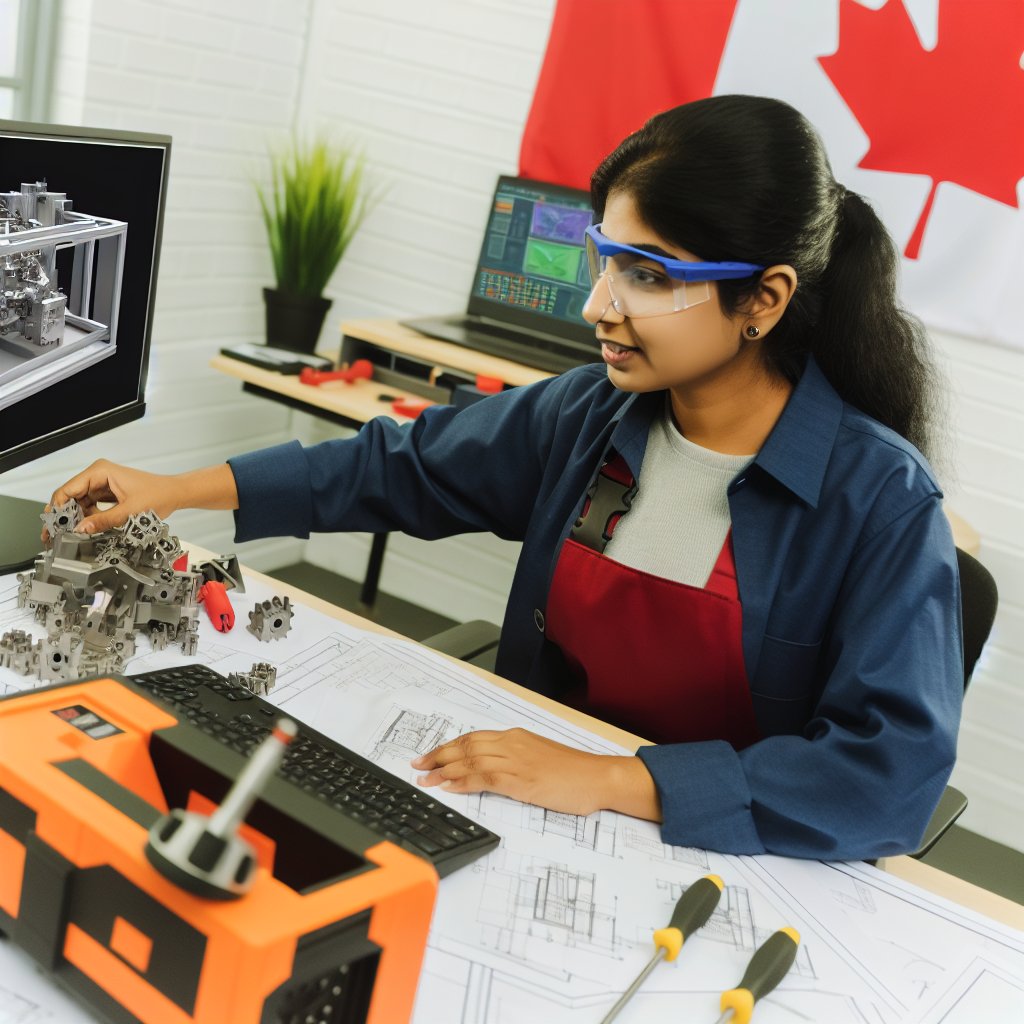Overview of Mechatronics Engineering
Definition
Mechatronics engineering combines mechanical, electrical, and software engineering.
This interdisciplinary field focuses on the design and creation of intelligent systems.
Mechatronics engineers integrate physical devices with smart control systems.
Key Components
The core components of mechatronics engineering include sensors, actuators, and control systems.
Sensors collect data from the environment and feedback systems.
Actuators convert electrical signals into physical movements.
Control systems manage the behavior of the machine based on input from sensors.
Applications in Manufacturing
Mechatronics plays a vital role in modern manufacturing processes.
Automated production lines use mechatronic systems to optimize efficiency.
These systems enhance precision and reduce human error.
Additionally, robotics in manufacturing is a key area of application.
Robots equipped with mechatronic technologies can perform complex tasks.
Benefits of Mechatronic Systems
Mechatronic systems improve product quality and consistency.
They also significantly increase production speed.
Moreover, these systems can be remotely monitored and controlled.
As a result, they reduce operational costs and enhance safety.
The Role of Mechatronics in Modern Canadian Manufacturing Processes
Enhancing Efficiency
Mechatronics integrates mechanical engineering, electronics, and computer science.
This combination streamlines manufacturing processes in Canada.
As a result, companies can produce high-quality products more efficiently.
Moreover, automation plays a crucial role by reducing human error.
Consequently, workers can focus on complex tasks that require critical thinking.
Driving Innovation
Mechatronics fosters innovation in manufacturing technologies.
This field promotes the development of smart machines and systems.
For example, robotics assists in assembly lines, enhancing speed and precision.
Additionally, sensors improve monitoring and quality control in real time.
Unlock Your Career Potential
Visualize a clear path to success with our tailored Career Consulting service. Personalized insights in just 1-3 days.
Get StartedThus, these advancements lead to the creation of new manufacturing processes.
Supporting Sustainability
Mechatronics contributes to sustainable manufacturing practices.
It helps reduce waste and energy consumption during production.
Furthermore, advanced controls optimize resource use in factories.
This shift towards greener technologies aligns with Canadian environmental goals.
Consequently, companies can improve their reputation while saving costs.
Preparing the Workforce
The rise of mechatronics creates new job opportunities in Canada.
As a result, educational institutions adapt their curricula to meet industry demands.
Programs now focus on integrating technology and hands-on training.
This prepares graduates to tackle challenges in modern manufacturing.
Moreover, ongoing training ensures the workforce remains competitive in the market.
Challenges and Opportunities
Implementing mechatronics still presents challenges for manufacturers.
Initial costs for technology integration can be substantial.
However, the long-term benefits often outweigh these upfront investments.
Moreover, staying updated with rapid technological advancements is essential.
Embracing these changes can lead to significant growth and innovation across the sector.
Career Opportunities in Mechatronics Engineering within Canada
Expanding Job Market
The job market for mechatronics engineers in Canada is growing rapidly.
Manufacturing companies increasingly seek skilled professionals.
This growth stems from advancements in automation and robotics.
Diverse Industries
Mechatronics engineers find opportunities in various sectors.
Key industries include automotive, aerospace, and electronics.
Each sector values the integration of mechanical, electronic, and software engineering.
Significant Employers
Several prominent companies are hiring mechatronics engineers across Canada.
For example, Bombardier focuses on aerospace innovation.
Meanwhile, Magna International leads in automotive solutions.
Additionally, companies like Siemens provide diverse engineering roles.
Remote Work Opportunities
Remote work has become more common in engineering fields.
Many companies offer flexible work arrangements.
This trend expands job accessibility across Canada.
Emerging Technologies
Mechatronics engineers work with cutting-edge technologies.
Artificial intelligence and machine learning are critical to modern applications.
Engineers also engage with Internet of Things (IoT) technologies.
Career Progression
Career frameworks for mechatronics engineers are well-defined.
Entry-level positions often lead to opportunities in project management.
Professional development is available through certifications and workshops.
Impact of Innovation
Innovation plays a pivotal role in engineering career outcomes.
Engineers contribute to designing smarter manufacturing processes.
Moreover, they enhance product development and industrial automation.
Networking and Professional Organizations
Networking significantly impacts job prospects in this field.
Organizations such as the Canadian Society of Mechanical Engineering provide resources.
Attending industry conferences can lead to valuable connections.
Future Trends
The demand for mechatronics engineers will likely continue to rise.
Adoption of Industry 4.0 practices will drive this growth.
A dynamic future awaits professionals in mechatronics engineering in Canada.
Find Out More: Day-to-Day Life of a Petroleum Engineer Explained
Educational Pathways: Programs and Institutions Offering Mechatronics in Canada
Mechatronics engineering is a multidisciplinary field combining mechanics, electronics, and computer science.
Canadian educational institutions offer various programs in this dynamic field.
Students can pursue undergraduate and graduate degrees in mechatronics engineering.
Additionally, many colleges offer diplomas and certificate programs.
Universities Offering Mechatronics Programs
Several top Canadian universities provide specialized mechatronics programs.
The University of Toronto features a comprehensive undergraduate program.
McGill University offers a robust master’s program in mechatronics.
The University of Alberta integrates mechatronics into its engineering curriculum.
Students can benefit from hands-on learning opportunities in these programs.
Colleges with Mechatronics Diplomas
Many colleges across Canada provide diploma programs in mechatronics.
George Brown College stands out with its innovative curriculum.
Fanshawe College also offers specialized training in mechatronics technology.
Students can gain practical skills and industry experience through these programs.
Online Learning Opportunities
Online courses in mechatronics are increasingly popular among students.
Institutions like Athabasca University offer distance education options.
Students can complete their coursework from anywhere in Canada.
This flexibility accommodates working professionals seeking to advance their education.
Staying Updated with Continuing Education
Continuous education is essential in the rapidly changing field of mechatronics.
Many institutions offer workshops and short courses to keep skills current.
Industry-focused programs can enhance expertise in specific technologies.
Professionals can stay competitive by engaging in lifelong learning.
Uncover the Details: Exploring Job Opportunities in Aerospace Engineering
Impact of Automation and Robotics on Canadian Manufacturing Industries
Introduction to Automation
Automation significantly transforms the manufacturing landscape in Canada.
By incorporating technology, companies enhance productivity and efficiency.
Furthermore, automation minimizes human error in production processes.
Role of Robotics in Manufacturing
Robots play a crucial role in modern manufacturing.
These machines perform repetitive tasks with high precision.
Additionally, robots can work in hazardous environments safely.
As a result, they reduce workplace injuries and improve overall safety.
Benefits of Automation and Robotics
Automation leads to significant cost savings for manufacturers.
Companies experience reduced labor costs due to higher efficiency.
Moreover, automation enhances production speed and quality.
This ensures that products meet strict market demands.
Challenges to Implementation
Despite the advantages, challenges exist with automation.
Initial investment costs can be prohibitively high for some companies.
Moreover, there is a need for skilled workers to operate advanced systems.
Training employees poses an additional challenge for firms.
Case Studies of Successful Implementation
Canadian companies provide excellent examples of successful automation.
For instance, Maple Leaf Foods implemented robotics to streamline operations.
This led to increased production and improved product consistency.
Additionally, Bombardier Aerospace uses automation in aircraft assembly.
The results are higher efficiency and reduced production timelines.
Future Trends in Automation
The future of Canadian manufacturing looks promising with automation.
Emerging technologies like AI will further enhance productivity.
Additionally, Industry 4.0 will create smarter manufacturing systems.
As a result, companies will gain more adaptability and efficiency.
Moreover, advancements in robotics will allow for more versatile applications.
Implications of Automation in Manufacturing
Automation and robotics have become vital in Canadian manufacturing.
They drive growth and competitiveness in an evolving market.
Consequently, it is crucial for businesses to embrace these technologies.
Find Out More: Internship Tips for Aspiring Biomedical Engineers

Challenges and Innovations in Mechatronics Engineering in Canada
Current Challenges
Mechatronics engineering faces several challenges in Canada today.
One major issue is the integration of new technologies.
Companies often struggle to incorporate robotics with existing systems.
Additionally, there is a significant skills gap in the workforce.
Many graduates lack hands-on experience with modern equipment.
This gap hinders the growth of innovative manufacturing techniques.
Furthermore, the high cost of cutting-edge technology remains a barrier.
Organizations must invest significant resources to stay competitive.
Innovations in the Field
Despite challenges, Canada is a hub for exciting innovations in mechatronics.
Many firms explore artificial intelligence for increased efficiency.
AI algorithms optimize robotic systems for better performance.
This automation reduces human error and improves production rates.
Moreover, companies are developing collaborative robots, or cobots.
These machines work alongside humans to enhance productivity.
Notably, advancements in sensors and control systems drive innovation.
They facilitate real-time data analysis for smarter operations.
Future Prospects
The future of mechatronics engineering looks promising in Canada.
As technology continues to evolve, new opportunities will arise.
Companies will increasingly adopt advanced manufacturing practices.
This shift is crucial for meeting the demands of a competitive market.
Partnerships between universities and industries will strengthen innovation.
Collaboration can lead to knowledge transfer and skill development.
Furthermore, investment in research and development will foster growth.
Overall, mechatronics engineering will play a vital role in Canada’s manufacturing landscape.
Uncover the Details: Job Hunting Tips for Petroleum Engineers in Canada
Case Studies of Successful Mechatronics Applications in Canadian Manufacturing
Automated Manufacturing in Ontario
In Ontario, a leading automotive manufacturer adopted mechatronics for efficiency.
This manufacturer integrated robotics into their assembly lines.
As a result, they reduced production times significantly.
Furthermore, they enhanced product quality and consistency.
This implementation reduced human error during assembly.
Innovative Food Processing in Quebec
A food processing company in Quebec implemented advanced automation.
They utilized mechatronics to streamline their packaging process.
This strategy improved productivity and reduced waste.
Moreover, the automated systems ensured better hygiene and safety practices.
Consequently, the company experienced increased market competitiveness.
Robotics in Aerospace Manufacturing
In British Columbia, an aerospace firm adopted robotic systems.
This firm focused on precision and quality in manufacturing parts.
Mechatronics facilitated accurate assembly of complex components.
The result was a significant reduction in costs and lead times.
Additionally, the company improved its ability to meet industry standards.
Smart Warehousing Solutions
A logistics company in Alberta embraced mechatronics for warehousing operations.
By implementing automated guided vehicles, they optimized inventory management.
This innovation led to faster order fulfillment rates.
Additionally, it reduced labor costs effectively.
The smart systems enhanced accuracy in tracking inventory levels.
Custom Textile Production
A textile manufacturer in Manitoba employed mechatronics for customization.
Using automated weaving machines, they achieved precise patterning.
This flexibility allowed for rapid response to market demands.
Furthermore, the company expanded its product line without significant investment.
Such advancements strengthened the company’s position in the market.
Future Trends in Mechatronics and Their Implications for Canadian Manufacturers
Technological Advancements
Mechatronics engineering blends mechanical, electrical, and software engineering.
This integration leads to smarter manufacturing processes.
As technologies evolve, manufacturers will adopt more automation.
For instance, robotics will increase in various sectors.
Additionally, artificial intelligence will enhance decision-making.
Shift Towards Industry 4.0
Industry 4.0 represents a leap in manufacturing practices.
It focuses on cyber-physical systems and data exchange.
This shift demands a skilled workforce familiar with digital tools.
Moreover, companies must invest in IoT solutions.
Ultimately, real-time data will improve efficiency and production.
Environmental Considerations
Sustainable practices are becoming essential in manufacturing.
Mechatronics can support eco-friendly initiatives.
For example, energy-efficient systems reduce waste.
Moreover, smart manufacturing minimizes resource usage.
As a result, companies can lower their carbon footprint.
Collaboration and Innovation
Collaboration fosters innovation in mechatronics engineering.
Partnerships between companies and universities are crucial.
Research and development lead to cutting-edge solutions.
Furthermore, sharing knowledge accelerates technological advancements.
Ultimately, a collaborative approach will strengthen Canadian manufacturing.
Impact on Workforce Skills
The evolving landscape of mechatronics requires new skills.
Workers must adapt to advanced technologies quickly.
Training programs will need to focus on digital competencies.
Additionally, soft skills are vital for teamwork and problem-solving.
Future workers must embrace lifelong learning to stay relevant.
Additional Resources
Welcome to Mechanical and Mechatronics Engineering at the …
Farhan Raza – Technical Officer in Mechatronics and Laboratory …




